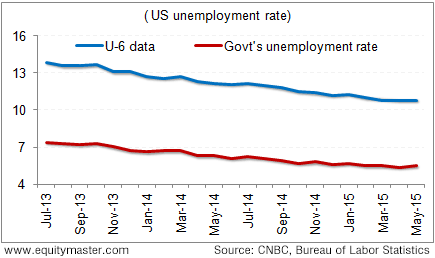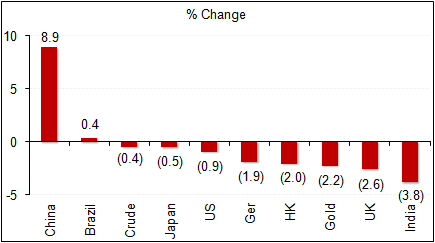Is this all it takes to make a killing in stocks?
In this issue:
» Has the US job situation really improved?
» Banking sector's woes to worsen?
» Indian stocks: The worst performers this week
» ...and more!
00:00 |
 |
|

|
As defined on Investopedia, EVA is "a measure of a company's financial performance based on the residual wealth calculated by deducting cost of capital from its operating profit (adjusted for taxes on a cash basis).
The formula for calculating EVA is as follows:
What this metric aims to estimate is the value a company creates in excess of the required rate of return expected by its shareholders.
As you would agree, people invest money in various instruments with the aim to maintain their purchasing power and improve the same over the long term. What would make sense for them is to beat the annual cost of increase in expenses (inflation per se).
The concept essentially remains the same for the corporate sector too. They have certain costs such as cost of debt and cost of equity that they aim to beat. If companies are able to do so, it only adds to their value; if they cannot, then it lowers the value of the business. If a company is able to deploy cash in a manner that beats the opportunity costs, it would be worth more. Add growth to it and the value only improves. And if a company is able to do both for long periods of time, it is pretty much a jack pot from an investor's perspective!
I thought it would be a good exercise to see whether this theory holds true.
With the help of our database tool, I pulled out the return on equity and D/E ratios for the entire universe (barring financials and banking businesses) for the decade ending 2010. The tool threw up a list of 1,829 companies. Thereafter, I only included those companies which had a minimum RoE of 15% (long term returns of the Sensex) in each of the financial year of this period. Further, I excluded companies which had D/E ratio of more than 1x in any one of the years of this period. The latter was done to avoid the possibility of RoEs being influenced by high debt on books.
A total of 42 companies met these criteria.
Then, I calculated the stock returns of these 42 companies in the past five years - i.e. from June 2010 to June 2015. I would like to point out here that this exercise does remove the factor of hindsight bias as the financial data is gauged for the period prior to calculating these returns.
The results here did pretty much surprise me! Out of these 42 companies, 40 of them beat the Sensex's returns of 9.4% per annum during this period. This is a success ratio of as high as 95%. The average returns of this group of stocks came in at a whopping 42% per annum!
And mind you, this was not really at a time when valuations of the Indian markets were depressed. In fact, the TTM valuations of the benchmark index five years ago stood at about 20x, higher than the current levels of about 19.3x. Even in terms of price to book value, the index five years ago was trading at a multiple of 3.4x as compared to the current multiple of 2.87x.
Here's a very apt quote by Charlie Munger that would well summarize this discussion - "Over the long term, it's hard for a stock to earn a much better return than the business which underlies it earns. If the business earns 6% on capital over 40 years and you hold it for that 40 years, you're not going to make much different than a 6% return-even if you originally buy it at a huge discount. Conversely, if a business earns 18% on capital over 20 or 30 years, even if you pay an expensive looking price, you'll end up with a fine result."
Do you believe good investing can be as simple as investing only in businesses with consistent above average return ratios? Let us know your comments or share your views in the Equitymaster Club.
|
--- Advertisement ---
Is It Time To Be Greedy Or Fearful? The stock markets have crashed and a number of stocks have taken a beating. And now, many common investors feel it's better to stay away from stocks right now. But what if we told you this could be an ideal time to get Greedy about stocks? And not only that, what if we told you this is actually a wonderful opportunity to grab some very good stocks at bargain prices? Yes, we've revealed details of 3 such stocks you could consider buying right away in our new special report... which you could obtain for absolutely FREE! Click here for full details... ------------------------------ |
02:15 |
Chart of the day | |
Sometime back, it was new formula based GDP numbers of India that caused much controversy. Recently, this anomaly between the statistics and what could be the real situation was captured in case of reporting of US unemployment data. As per the US Labour Department, the unemployment rate was 5.5% in May. However, if one considers the metric used by Bureau of Labor Statistics to capture unemployment rate (known as U-6), it comes to 10.8% for May, almost double. What the latter captures is the unemployed, under employed and discouraged, which we believe makes more sense.

|
Unemployment data reported by US Labour Department could be strong enough for Fed to hike rates soon. However, the IMF believes that could be premature, considering a fragile recovery! On the other hand, Mark Faber has something different to say. He is hardly bothered over the expected rate rise. The renowned editor and Publisher of Gloom, Boom and Doom compares US economy to a sinking ship and expects it may unleash another round of Quantitative Easing.
Whether it is a rate hike or Quantitative Easing in US, the impact on India is likely to be disturbing. The former can lead to the flight of foreign money thus rattling Indian markets. On the other hand, the latter can lead to too much of idle money chasing high return assets leading to a bubble across asset classes. So how can a common investor shield himself from such developments? We believe that one of the best ways to do so could be bottom up investing and asset diversification.
03:20 |
 |
|
Public sector banks are required to lend to the farming community at subsidized rates under the priority sector lending rules of RBI. Reportedly, Indian banks have a total farm loan outstanding of Rs 7.8 trillion as on April 2015. The farm loan target has been further hiked to Rs 8.5 trillion in the Union Budget 2015. But the possibility of crop failure in a drought year increases the risk of farm loans turning bad. This is especially true as the government steps up populist measures such as farm loan waiver and rescheduling of loans. While this might seem to be inevitable, statistics paint a different picture. Farm loans have been growing in double digits even as agricultural growth has been in low single-digits. Therefore instead of just focusing on providing funds, the government should help the farming community improve its crop yields through better and innovative cultivation techniques. Unless these real issues are addressed, the banking sector will continue to remain vulnerable to the vagaries of the weather.
04:10 |
 |
|
In Europe, the Eurozone-Greece negotiations have reached a crucial stage. There is still no clarity about the final outcome. Greece has already delayed one payment to its creditors as the negotiations continue. This uncertainty weighed down European markets this week.
Indian markets fared the worst this week after the RBI cut the benchmark repo rate by 0.25%. The markets were hoping for a larger cut. The RBI also stated that it had limited room to cut rates further due to concerns over a deficient monsoon.

|
04:55 |
Weekend investing mantra |
Today's Premium Edition.
Today being a Saturday, there is no Premium edition being published. But you can always read our most recent issue here...
Recent Articles
- All Good Things Come to an End... April 8, 2020
- Why your favourite e-letter won't reach you every week day.
- A Safe Stock to Lockdown Now April 2, 2020
- The market crashc has made strong, established brands attractive. Here's a stock to make the most of this opportunity...
- Sorry Warren Buffett, I'm Following This Man Instead of You in 2020 March 30, 2020
- This man warned of an impending market correction while everyone else was celebrating the renewed optimism in early 2020...
- China Had Its Brawn. It's Time for India's Brain March 23, 2020
- The post coronavirus economic boom won't be led by China.
Equitymaster requests your view! Post a comment on "Is this all it takes to make a killing in stocks?". Click here!
8 Responses to "Is this all it takes to make a killing in stocks?"
Al
Jun 9, 2015It would be extremely helpful for serious investors if Equitymaster would make its database tool available to readers on a subscription basis. Subscribers can then come up with their own investment strategies and perhaps discuss them in a mastermind group private forum.
ANIL BATRA
Jun 8, 2015It is a wonderful way of finding the strongest companies and timing also do not make a difference.One can keep accumulating them and Sell NEVER.
P Srinivasan
Jun 8, 2015A different approach and many thanks for sharing this. It will be interesting if you can let us know the extent to which the downside was limited during the bear phase when compared to benchmark index
Request you to share the list.
Vipul
Jun 8, 2015Analysis by Devanshu Sampat was really worth knowledgable. But one thing I would like to say is that cash flow and cash generating capacity plays very important role in any business. Even though we do give importance to non-cash item like depreciation, but at the end, we should give importance to cash generating capacity of any business/industry/company.
R Balakrishnan
Jun 7, 2015ROE is perhaps the only true long term barometer. Circa 1997, I had done a study of the BSE 200 for ten year returns. The returns matched the ROE ranks, except for two companies- Gujarat Abuja and HDFC Ltd! I called it the 'faith premium'! This study was published in Business India ( a once prominent biz magazine).
R Balakrishnan
R.Adwani
Jun 7, 2015I would be thankful to you if you could please send me the list of 42 companies which you have mentioned in the article on EVA.
C K VAIDYA
Jun 6, 2015You seem to have taken 15% as expected rate of return on equity of each and every company irrespective of nature of their business, actual D/E ratio etc.
While this itself may have impacted choice of some companies in your list of 42, I would be curious to know if you tried to find any correlation between the EVA generated by companies with the returns that shareholders enjoyed.
You have also not mentioned how much excess returns shareholders of these companies got compared to Sensex.
Lastly, I would request you to share the list of these 42 (40?) companies.
Regards


Nitin Mehta
Jun 11, 2015EVA is a strong methodology of assessing a company.
Your research is quite interesting based on parameters considered.
I request you to please share the list of 42 companies with statistical data that you have zeroed on.